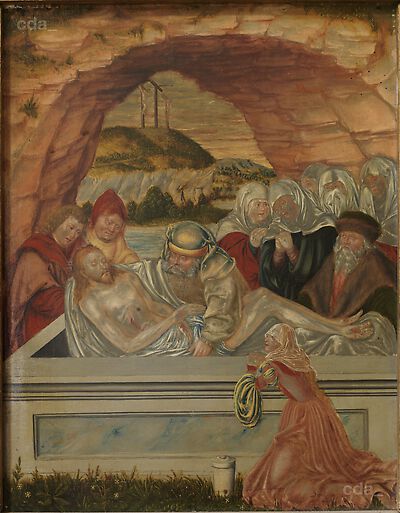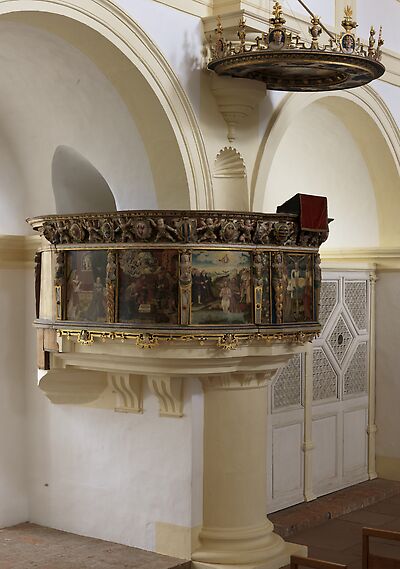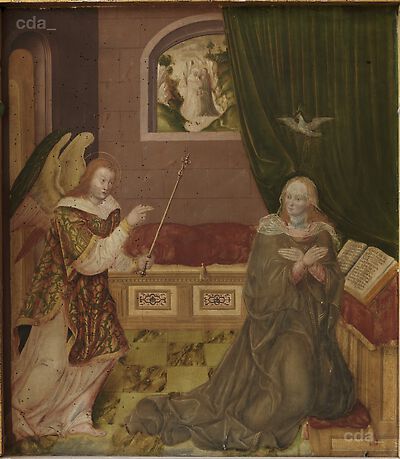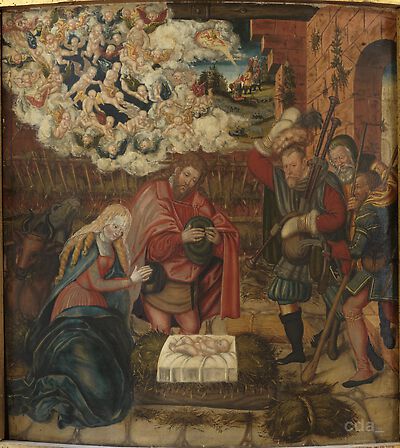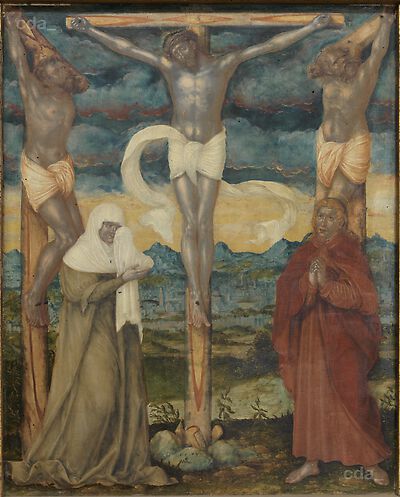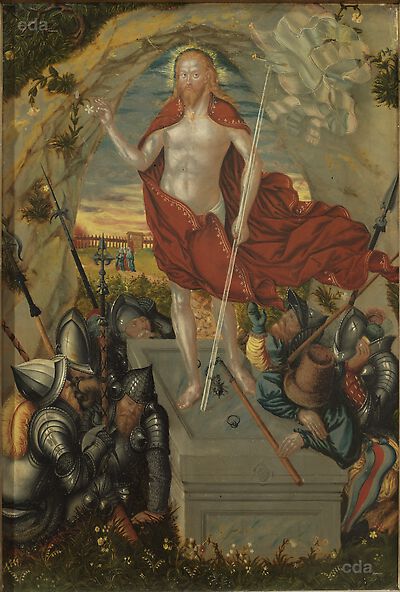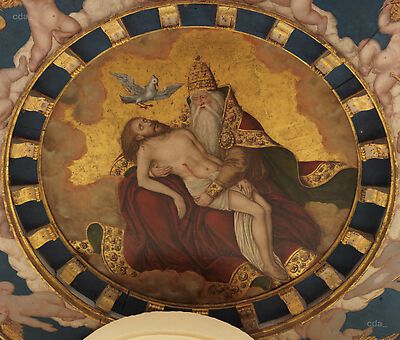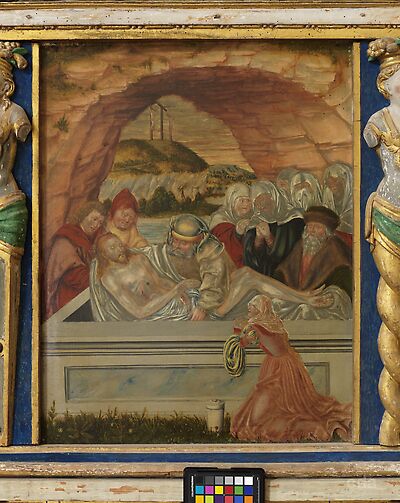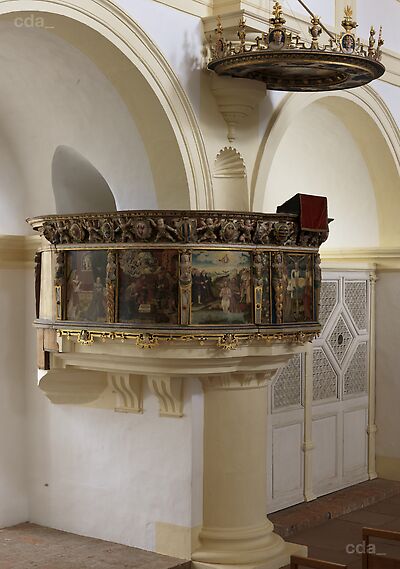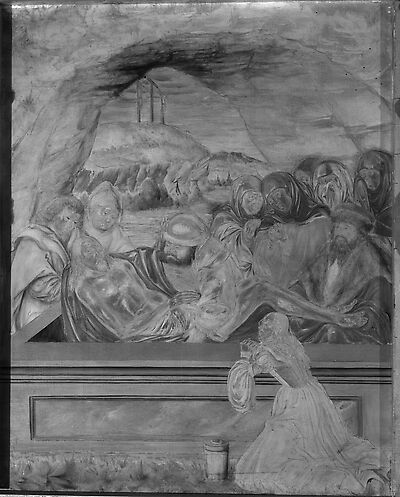Support
The panels are mounted in the pulpit and due to the coniferous wood paneling are not accessible from the reverse, therefore any assessment of the support remains conditional. In the few areas where bare wood is visible it is pale in appearance.
The examination report from 1990 of the conservation of the abat-voix states that its panel painting was executed on lime wood. The support of the altarpiece created by Cranach the Younger for the castle chapel was also lime wood. It may therefore be assumed that the pulpit paintings were also painted on lime wood.
When viewed in raking light a slight unevenness of the surface suggests that the panel consists of five planks.
[Herrschaft 2013, 35, 37]
Ground and Imprimatura
A thin glue-chalk ground was applied with a brush to the sized support. On the right and left edges of the panel the ground extends to the edge of the support. The upper edge of the panel appears to have a continuous barb, which is visible on the left half of the panel. It may be assumed that the panel was fixed in plane along at the top and bottom edges by a grooved batten while the ground was applied. There is a thin lead white imprimatura covering the ground.
[Herrschaft 2013, 39]
Underdrawing
The underdrawing on the pulpit paintings was executed on the imprimatura. The lines were carried out in a dry drawing material, possibly a grey/black chalk. The underdrawing for the Entombment scene conforms with the style of the other underdrawings, but is is some areas barely, if at all visible. The delicate lines of the contours roughly correspond with the painted version without compositional changes unlike in the scenes of the Baptism and the Crucifixion. Description of the inner forms is clearly visible in the garments of the Virgin and Mary Magdalene. Whereas in the former the sleeves are indicated by a few curved lines, the underdrawing lines in Mary Magdalene's garments are straight and more angular, but in part also wiggly. As always the lines are rarely binding.
In the background the underdrawing for the landscape consists again of only a few curved lines and trees are indicated by arcs. Also here numerous forms were clarified during the painting process, but to a lesser degree.
[Herrschaft 2013, 41]
Paint Layers and Gilding
The paint layers probably consist of pigments bound in oil (a test for protein proved negative). On all the panels the paint layers extend to the edge at the sides - like the ground - whereas the paint layers at the top and bottom end before the ground.
By and large all the panels exhibit a very economic painting technique with a thin application of paint, which nevertheless is predominantly opaque. In addition there are areas of glazed colour, where the imprimatura is occasionally visible and influences the colour scheme of the panel.
The quality of the painting is very mixed and reveals the cooperation of more than one person on each panel. Many of the affectionately executed details are only visible close up, which considering the position of the panels 2 meters above is never possible. Other areas are less precise and occasionally unfinished (this is also the case for the decorative painting on the pulpit).
In the Entombment scene the red coats worn by two of the Virgin's companions and that of St John were executed in opaque paint, which probably contains vermilion. The arrangement of the folds was applied over this in dark to black lines. The lining of St John's coat is lighter with brownish-red glazes used for the folds and the shadows. On the left edge of the painting the glaze employed here is visible as a slightly fuchsia-coloured bright red. Mary Magdalene's skirt is executed in the same brownish-red paint. The flat application over the ground was finished with white highlights.
The sleeves of Mary Magdalene's undergarment are painted blue (presumably azurite) in the recesses of the folds and a light grey was glazed over the raised areas. Delicate lines in light yellow serve to depict light reflexes. Joseph of Arimathea’s headdress was painted in the same manner. The fabric was roughly executed in grey glazes and dark blue paint and the precious surface texture was then achieved employing delicate, close strokes in light yellow. His robe on the other hand was painted using smalt. The Virgin’s dark blue coat was executed using azurite, which was mixed with black for darker areas. Finally the modulation and the folds were executed in an admixture with white.
The flesh paint of the people present was executed employing different techniques. The faces of Nicodemus and Joseph of Arimathea are similar to the faces in the Baptism scene. A light flesh tone was used to model volume over a translucent brown layer, thus with the exception of the eyelids and the nostril no outlines were required. The faces of St John and the Apostle beside him recall on the other hand the method employed for the faces in the Crucifixion scene (the Virgin and St John). Here also a dark grey was applied over a brown base tone and then the flesh tone was applied considerably thicker and is clearly distinguishable from the grey. The faces of the women present are not readily legible under the now greying paint layer. However they also exhibit a brown base tone, followed by a glazed flesh tone with a few dark brown lines to describe the contours of the eyelids and the nose.
The technique employed for the flesh paint of Jesus’ corpse is essentially the same as that used for the Crucifixion. However the brown base tone is lighter or more translucent in application, which is why the grey paint in the shadows applied subsequently is darker than the base tone and does not appear to have been integrated. The upper flesh tone is similarly ‘expressive’ in application to that of the Crucifixion scene.
[Herrschaft 2013, 58-60]
- written by Jana Herrschaft
